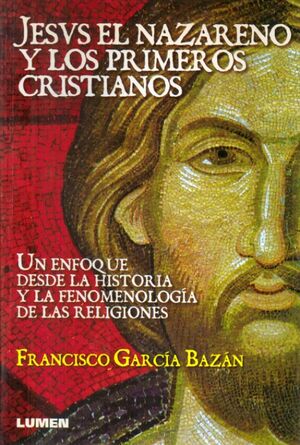Jesús el Nazareno y los primeros cristianos (2006 García Bazán), book
Jesús el Nazareno y los primeros cristianos: Un enfoque desde la historia y la fenomenología de las religiones <Spanish> / Jesus the Nazarene and the First Christians: A Historical and Religious-Phenomenological Approach (2006) is a book by Francisco García Bazán.
Abstract
"The present volume deals with the progress made in the study on the figure of Jesus and the first Christians from a historical-critical perspective, though using as well the phenomenological method. A critical study and a tentative reinterpretation of the most relevant data explored in past and present scholarship is provided within it. Its nine chapters give Jewish, early Christian, and Gnostic literature the place they all deserve in the study of the historical Jesus and the early Christian faith. Accordingly, the volume carefully examines the Hebrew and the Greek Bible, the Qumran scrolls, the works of Josephus, the Targumim, the pseudepigrapha and the apocryphal texts of the Old and the New Testament, the Synoptic Gospels, the Judeo-Christian writings, the Nag Hammadi library, and some early Patristic writings. The life and resurrection of Jesus; the notions of evils and Evil in late antiquity and Christian origins; the myth of the androgyne; the role played by asceticism and sexuality in early both Christianity and Gnosticism; and the primitive traces of Christian philosophy that may be found in the Gospel of Thomas are some of the main topics addressed in it. - Juan B. García Bazán, John F. Kennedy University
"Jesús el nazareno aborda el avance de los estudios sobre la figura de Jesus y los primeros cristianos.La investigación se apoya en la documentación científica comparada e integrada tanto por las fuentes y testimonios que provienen de los escritos canónicos como extracanónicos.Este conjunto es sometido al estudio crítico y a la correspondiente interpretación. y otorga a la líteratura judía. los manuscritos de Qumrán. los escritos judeocristianos. los textos apócrifos del Antiguo y Nuevo Testamento y la biblioteca de Nag Hammadi. el lugar que hoy día merecen junto a las investigaciones que estudian los libros del Antiguo Testamento en hebreo y griego. los targumín o paráfrasis aramaicas del A. T.. los cuatro Evangelios. y la literatura de los escritores eclesiásticos de la Patrística antigua."--Publisher description.
Editions
Published in Madrid [Spain]: Lumen, 2006 (ISBN 978-98-700-0642-8).
Reviews
Table of contents
- Introducción: Jesús el Nazareno
PRIMERA PARTE: EL CRISTO HISTÓRICO
- I. La fenomenología de la religión y la noticia del historiador Flavio Josefo sobre “Jesús el Cristo”…21
- II. La resurrección de Jesús el Nazareno examinada fenomenológicamente……49
SEGUNDA PARTE: JESÚS, LA FAMILIA, DISCÍPULAS Y DISCÍPULOS
- III. Los parientes de Jesús
- IV. Jesús y las mujeres
TERCERA PARTE: PROYECCIONES COMUNITARIAS
- V. Los males y el mal en la antigüedad tardía y los orígenes cristianos
- VI. Fenomenología del ascetismo y cristianismo primitivo
- VII. Matrimonio y ética de la sexualidad en el temprano cristianismo: protocatólicos, encratitas y gnósticos
- VIII. El mito del andrógino y la naturaleza humana. Núcleo clásico e irradiaciones helenístico-cristianas
CUARTA PARTE: HACIA EL FUTURO
- IX. Rastros primitivos de filosofía cristiana: el Evangelio de Tomás y su base gnóstico-sapiencial
- Conclusión y Prospectiva
